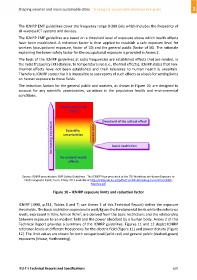Page 617 - Shaping smarter and more sustainable cities - Striving for sustainable development goals
P. 617
The ICNIRP EMF guidelines cover the frequency range 0‐300 GHz which includes the frequency of
all wireless ICT systems and devices.
The ICNIRP EMF guidelines are based on a threshold level of exposure above which health effects
have been established. A reduction factor is then applied to establish a safe exposure level for
workers (occupational exposure, factor of 10) and the general public (factor of 50). The rationale
explaining the lower safety factor for the occupational exposure is provided in Annex 2.
The basis of the ICNIRP guidelines at radio frequencies are established effects that are related, in
the radio frequency (RF) domain, to temperature rise (i.e., thermal effects). ICNIRP states that non‐
thermal effects have not been established and their relevance to human health is uncertain.
Therefore, ICNIRP states that it is impossible to use reports of such effects as a basis for setting limits
on human exposure to these fields.
The reduction factors for the general public and workers, as shown in Figure 10, are designed to
account for any scientific uncertainties, variations in the population health and environmental
conditions.
Source: ICNIRP presentation: EMF Safety Guidelines ‐ The ICNIRP View presented at the ITU Workshop on Human Exposure to
Electromagnetic Fields, Turin, 9 May 2013 available at http://emfguide.itu.int/pdfs/ITU‐EMF‐Workshop‐Turin2013‐ICNIRP‐
Matthes.pdf
Figure 10 – ICNIRP exposure limits and reduction factor
ICNIRP (1998, p.511, Tables 6 and 7; see Annex 2 of this Technical Report) define the exposure
thresholds. The basic restriction expressed in watt/kg are the fundamental limits while the reference
2
levels, expressed in V/m, A/m or W/m , are derived from the basic restrictions and the relationship
between exposure to an incident field and the power absorbed by a human body. Annex 2 of this
Technical Report provides a summary of the ICNIRP guidelines. Figures 11 and 12 depict ICNIRP
reference levels at different frequencies for the electric field (Figure 11) and power density (Figure
12). The limit values are shown for both occupational (solid‐red) and general public (dashed‐green)
exposures (Mazar, forthcoming).
ITU‐T's Technical Reports and Specifications 607

